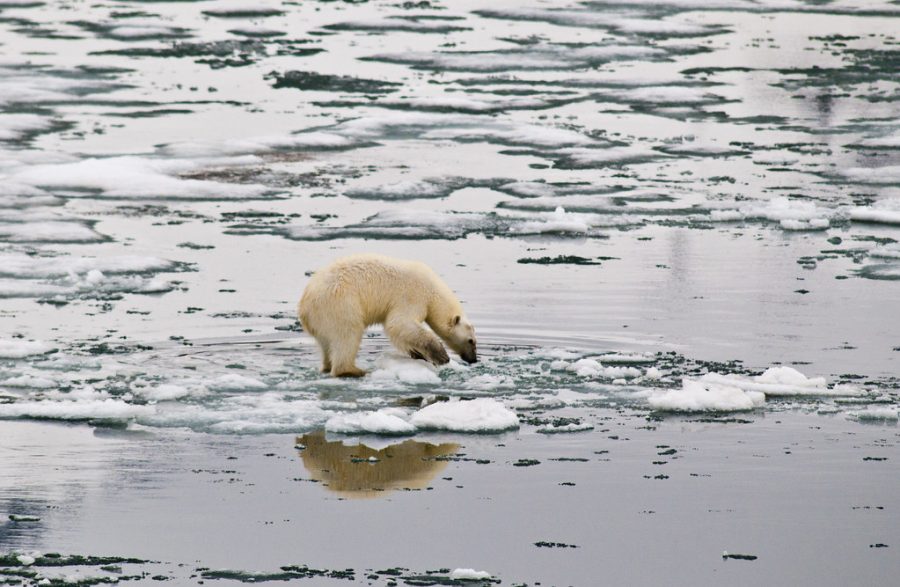Into the oil spill: The Willow Project
Oil drilling to take place in Alaska following the approval of the Willow project. Photo credit: Manuel Ernst., Polar bear on melting ice caps. Photo credit: Peter Prokosch.
The ConocoPhillips Alaska oil drilling project, named the Willow Project in mainstream media, was approved by the Biden administration on March 13 of this year amid protests from environmental organizations. The project will release around 287 million tons of carbon over its lifetime and is a marker of how seriously the United States takes its carbon footprint.
The Willow Project, run by American oil drilling company ConocoPhillips, will produce approximately 600 million barrels of oil and will make around eight billion dollars in revenue once completed. Since the project has only recently been approved, this oil would not come to the market until 2029.
Though the Biden administration only recently approved the Willow Project, ConocoPhillips has had leases on the project’s land since 1999. These leases give the company the right to begin developing the land at any time, and could cost the Biden administration up to five billion dollars to fight, according to an anonymous administration official.
However, in Biden’s 2020 presidential campaign, he explicitly promised prospective voters that there would be no new drilling under his presidency. Pete Erickson, an environmental researcher for Stockholm Environment Institute, said, “[The Biden Administration] could have said no, because President Biden, as president, is the boss of the Department of Interior [which manages public and federal lands].”
Still, Biden is contending with tremendous political pressure in the face of the coming election. “Honestly, [Biden’s] hands are a little tied with Russia invading Ukraine which has dramatically increased the natural gas, oil and gasoline oil prices. He has to be doing something to address those high energy prices,” said Geoff Ruth, an environmental science teacher. Energy independence, which is influenced by our competition with China, is a big goal for the United States and one of the main reasons for approving the Willow Project.
Environmentalists have also reported concern about the impact of drilling sites on the surrounding water resources, which are the habitats of sea and land animals. This area of federal land is a key habitat for polar bears and thousands of migrating caribou and waterfowl.
The project has also been referred to as a carbon bomb releasing over the course of 30 years, the equivalent of 4% of US annual emissions. Ruth said, “Alaska is the state that is probably most impacted by climate change [and] is seeing the biggest impacts from, for example, thawing permafrost which hugely disrupts all sorts of infrastructure across Alaska. Similarly, many coastal communities, whether they’re native communities or non native communities, are seeing a lot more erosion as a result of climate change.”
The Willow Project was heavily endorsed by state lawmakers in Alaska, and garnered a majority consensus from Indigenous communities who the project may impact. Part of this may lie in the working opportunities this creates for Alaskans. It could create 2,500 short-term jobs and 300 long-term jobs, as well as adding to the Alaska state revenue significantly. On top of this, the Alaska Permanent Fund gives $1,600 to Alaskan residents annually and is funded entirely by oil drilling revenue, which the Willow Project will only increase.
But beyond Alaska, the Willow Project has an impact on how seriously carbon emissions are taken. Samantha Littlejohn, environmental science teacher said, “In the big picture of the U.S. carbon emissions, the Willow Project is actually pretty small. But the bigger question to me is what are we doing as a country which has historically emitted massive amounts of carbon to actually, in the short term, shift away from fossil fuels?”
Even though the scale of the Willow Project is relatively small compared to global carbon footprint, environmentalists seem to agree that it is a step in the wrong direction. Green Team member Amelia Hayward ‘23 said, “Everybody should do what they can on an individual level to prevent climate change. But, and I don’t want to sound pessimistic, the real big step is attacking these big oil companies who have a monopoly on oil which goes to cars for gasoline to make plastic. They have so much power.”
Because the United States is a leading world power, this decision influences other countries as it is an active choice to prolong our dependence on fossil fuels. Christopher Gonzalez-Crane, an environmental history teacher said, “From an environmental standpoint, it speaks more to a degradation of ideology than an actual impact on global warming. If you actually run the numbers it’s around 1%, but that said, if there’s a drop in the bucket, there’s a leak in the roof.”












